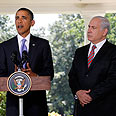
Netanyahu and Obama in Washington
צילום: AP
Peace? Yes, they can
Op-ed: Time to cast cynicism aside; Geneva model proves peace agreement is possible
How easy it is to approach the peace summit in Washington cynically. How easy it is to dismiss the images by uttering yet another remark about leaders who look good in photographs. They’ll be saying nice words but doing nothing. How easy it is to say that, again, nothing shall come out of it, because we already got used to that. How easy, and how false, it is.
We believe that both sides want peace. We’re not sure whether they are willing to pay the price inherent in it, yet we know with certainty that they can. There are enough level-headed, moderate, experienced, and patriotic people on each side that can present the outline of a possible agreement without undermining each side’s vital interests whatsoever.
Prime Minister Benjamin Netanyahu declared his three red lines as a condition for any agreement: An end to the conflict, security arrangements, and recognition of Israel as the Jewish people’s national home. Meanwhile, President Abbas declared his own three red lines: A state to be established on territory equal in size to the land occupied in 1967, a Palestinian capital in east Jerusalem, and a fair solution to the refugee problem.
On the basis of the above positions, it is possible to secure an agreement, as a group of prominent figures from both sides proved a few years ago. The Geneva Initiative model is of course merely an example – if only the official representatives of both peoples can reach a better agreement.
Chapter 1 of the Geneva Accord notes that the final-status agreement puts an end to the era of conflict and opens a new era premised on peace, cooperation, and neighborly relations. Hence, Netanyahu’s first condition is met.
Chapter 5 notes that Palestine will be a demilitarized state; the initiative details thorough security arrangements, the makeup of Israel’s remaining military presence, and the types of strict monitoring at Palestine’s international crossings. Hence, Netanyahu’s second condition is met.
The joke’s on us
The Geneva Accord’s introduction and chapter 2 note that the agreement marks the recognition of the Jewish people’s right for a state as well as the recognition of the Palestinian people’s right for a state, without undermining the equal rights of citizens on both sides. The initiative also notes that both sides recognize Israel and Palestine as the national homes of the respective peoples. Hence, Netanyahu’s third condition is met.
The Geneva Initiative also notes that the territory to be handed over by Israel would be equal in size to the land area occupied in 1967, and that the Palestinians would be given an unpopulated area equal in size to the settlement blocs to be annexed by Israel. It was also agreed that all Arab neighborhoods in east Jerusalem would be handed over to Palestine and serve as its capital.
In addition, the accord details thorough arrangements for resolving the refugee problem, so that at the end of the process not even one refugee shall remain, without jeopardizing the State of Israel’s Jewish character. Hence, Abbas’ conditions are also met.
The two leaders to photographed at the Washington ceremony can return to the US capital, this time in order to sign an agreement. For once, we can put aside the cynicism, disparagement, and humor, because this joke comes at our expense.
A final-status agreement is not only necessary, it is also possible. We can only hope that those who currently object to models such as the Geneva Initiative won’t find themselves longing for such models in the future. So give Obama, Abbas, and Netanyahu some credit. Yes, they can.
Nidal Fuqaha and Gadi Baltiansky are the Executive Directors of the Geneva Initiative in Ramallah and Tel Aviv
- Follow Ynetnews on Facebook










